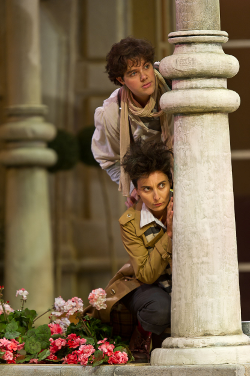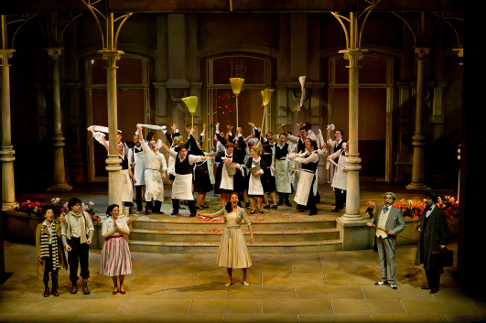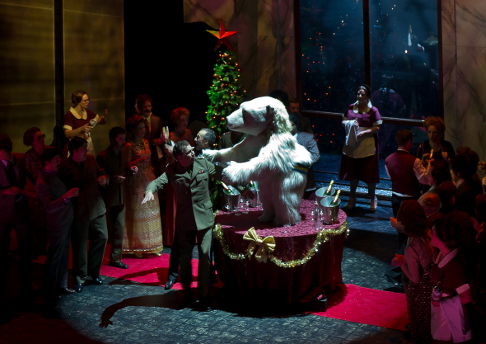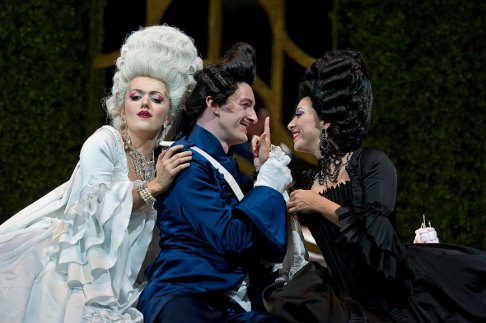This annual Irish celebration of opera’s oddities continues to confound
all typical safe season planning, yet it succeeds, and brilliantly. The reasons
are many. There are those of us who are starved for anything — well, almost
anything — that is not another Così or Carmen or
Figaro, especially when they are so frequently destroyed these days by
self-indulgent directorial concepts. Wexford has not only nurtured a
well-deserved reputation for choosing wisely, and with a trusted sense of
adventure, but also produces these rarities with loving care, featuring
talented star-singers-on-the-verge, and handsome, sensible productions that
actually (gasp) tell the story (were you seated?). That alone sets it
remarkably apart from 80% of what is on view on European stages, including most
higher ticket festivals.
But best of all, it allows the vast majority of us to come to the shows with
a real sense of discovery, an anticipation of spontaneity of musical
experience, and with no other singers/orchestras in our ears. This makes the
exposure especially important and fruitful for the young (and young-ish)
soloists, since they are not being compared to Beverly or Placido or Sam or
Regine or the Vienna Phil, who never recorded nor performed these parts. (At
the first performance I attended, a woman in front of me turned around and
asked “Have you heard this opera?” And I could honestly reply, “I don’t
think anyone has!” When is the last time you could say that in a opera
house…?)
Ambroise Thomas is well known for his tunefully grandiose, if dramatically
flawed pieces Hamlet and Mignon, with their oft-excerpted set
pieces well represented on recital discs. But Thomas also penned a delectably
effervescent comedy La Cour de Célimène that, if this mounting were
any indication, deserves much wider exposure. From the downbeat, the orchestra
under Carlos Izcaray set the bar very high indeed with a glowing, breathless
prelude that was not only characterized by virtuosic playing from the winds
(executing a manic noodling that was like “Flight of the Bumble Bee” on Red
Bull), but also rich playing from the banks of strings. Maestro Izcaray
displayed a fine command of the comic pacing and the overall propulsion of the
piece, and he elicited a beautifully filigreed succession of instrumental
details that imparted substantial delight.
The central role of the Countess was authoritatively assumed by the
drop-dead-beautiful blond Irish soprano Claudia Boyle. Whatever “star
quality” is, she has enough left over to bottle it and sell it. Vocally, Ms.
Boyle’s instrument recalled a young, vibrant June Anderson with clearer
diction. The top is gleaming, the coloratura was dispatched with breathtaking
agility, and the mid and lower ranges were creamy enough to churn a pound of
Kerrygold. This is a poised, well-schooled singer on the verge of international
acclaim. She soon will undertake Cunegonde in Rome and her showpiece aria in
Act Two gave a nod to “Candide” with a wacky, deftly timed sequence where
the diva was dressed in an eye-popping white gown, and then accessorized with
extravagant Bling. The high-flying vocal riffs were so similar to “Glitter
and Be Gay” as to be uncanny. (Dyasuppose Lenny knew this opera?) Claudia
Boyle. Watch for her.
Claudia was well matched by the Baroness, securely sung by Nathalie Paulin,
who is possessed of a haunting, softly-grained soprano that is by turns warmly
sympathetic and potently aggressive as required. She partnered Ms. Boyle
flawlessly as the two meandered in extended passages of melismatic thirds that
were faultlessly tuned and wonderfully coordinated. Luigi Boccia’s
still-developing tenor started off the night a bit like the Wexford weather:
cloudy with a chance of strain. But he came back in Act II and regaled us with
a clear, ringing lyric that displayed not only good promise, but real
accomplishment. I would welcome hearing him again soon. John Molloy’s
Commander of Beaupré was charismatically sung, albeit with a somewhat dry,
open tone that threatened to spread in the upper reaches. Some of this was
attributable to his over the top approach, which it must be admitted
capitalized on his considerable stage savvy. In Act I especially, his spoken
lines might have benefitted by dialing down the volume knob, since much of what
he orated seemed self consciously enclosed by quotation marks. Mr. Molloy found
his stride in Act II where his declamations belonged more to the heightened
style of the Comédie-Française than in the unamplified carnival barker of the
first half; and where his singing rolled forth to produce some outstanding
phrasings.
 Scene from Gianni Di Parigi
Scene from Gianni Di Parigi
The physical production as imagined by set and costume designer Paul Edwards
was a visual delight. Suggesting the skewed machinations of the plot, the
entire stage was slightly raked from right to left, with a slanted gold border
framing the playing space, and a black and white period etching on the scrim
curtain. A text in French proclaimed that the depicted noblewoman reigns over
all hearts. When the scrim flies, it reveals a verdant, stylized green
semi-circle of six arbors with a pink topiary heart-pierced-by-an-arrow in a
planter stage center. The floor of alternating black and white marble squares
in concentric circles was topped by a tromp l’oeil ceiling to complete a most
elegant playing space. For Act Two, the archways were filled with mirrored
biparting doors, and the heart gave way to a huge white round tufted settee.
Mr. Edwards’ costumes were sumptuous and character-specific, including the
twelve suitors in a riot of jewel-toned waistcoats. Ms. Boyle could hardly have
been dressed to better advantage with Act I’s lush deep rose gown replaced by
a dazzling white version in Two. The extravagant wigs and make-up were
similarly exemplary. One caveat about the tilted picture is that the audience
eventually tilted, too, lining up our necks with the picture!
Director Steve Barlow presented varied stage pictures and devised meaningful
movement for his troupe. Indeed, he excelled at drawing forth personalized
performances from each character, and did much to delineate the suitors. When
they first appear singly, each took the stage with a definite point of view,
and the ensemble sustained this throughout the night. The team crafted a
spectacular star entrance for the Countess who flies in on a love seat
suspended by ropes of flowers (the seat belt, too!), with a steady rain of pink
petals from on high. She ascends half-way up at Act’s end to open a fan that
announces Entr’acte. Act Two starts with a flurry of large pink
petals, so big they might hurt, to underscore the complications that the
pursuits have incurred. Although the piece does suffer from a sameness of plot
twists, Mr. Barlow kept the journey fresh and inventive with inspired business.
The nutty sword fight between the tenor and bass was a silly shadow screen
effect on the front scrim that mined every titter of humor from that
convention; and the maid’s gathering of the pile of roses at the Countess’
command was a brilliant goof. Having scooped the bouquets and hefted them up
off the floor, she pauses a moment, and instead of lovingly taking them off
with her, she suddenly and violently pitches them in disgust through the fourth
wall onto the apron! Startling and hilarious.
The other comic opera, Donizetti’s Gianni di Parigi, was just as
professionally staged, if a mite more challenging. For the opus is one long
sustained joke that finds the Dauphin (in disguise as Gianni) commandeering
(buying) an inn, barring it from use as arranged by the Princesse of Navarre
and her party, who are traveling to Paris for her to be wed to …the Dauphin.
Left to the mercy of Gianni’s hospitality, the heroine accedes that he is in
control of the situation, fully knowing (nyuk nyuk) that he is her betrothed.
Now, sustain this skeletal plot description for two hours and you will sense
the pitfalls. Happily, the work contains some worthy music that was winningly
performed.
If director Federico Grazzini did not offer the fresh kookiness that was
evident in the Thomas, he nevertheless drew on a reliable, clean, and utterly
workable staging tradition. Crowd management was effective and well motivated,
and the parade of repetitive eavesdropping scenes and largely decorative arias
were deftly handled. The chorus (singing splendidly during the entire Festival
under Gavin Carr’s leadership), were fleet of foot, consistent of focus, and
proved themselves to be fast change experts. (The dressers did yeoman work
backstage). Tiziano Santi provided an expansive, handsome, welcoming hotel
porch and garden that was a joy to inhabit for the evening. Valeria Donata
Bettella struck just the right note with her playful costumes.
 Full cast of Gianni Di Parigi
Full cast of Gianni Di Parigi
Zuzana Markova certainly gave an assured account of the Princess, coolly
elegant, utterly composed, and technically accomplished. What her pleasing
lyric voice may lack in individual timbre it makes up for with seamless
production, and consistent security above the staff. Her stratospheric
outbursts ‘in alt’ had a laser-like intensity. Edgardo Rocha brings a good
resume and even better intentions to the title role, and he has an engagingly
sweet voice, slender but pointed, and very well deployed in heartfelt
utterances of love and/or despair. I would urge him to resist pressing the
voice up to its very limit on passionate high notes, for we hold our breath
wondering if he will cross the line. Edgardo is not (yet) JDF. Or Lawrence
Brownlee. And that’s okay, because Mr. Rocha has many assets that are
uniquely his own, including a rumpled boyish appeal, and a warm demeanor. I
would hope that he pulls back just a little, and allows his voice to find its
natural path, which might yield even more impressive results.
Alessandro Spina’s robust bass was a definite highlight as a wiry Pedrigo,
and his seasoned buffo performing skills provided welcome diversion. He was a
fine foil for the Siniscalco of Alessandro Luongo whose baritone was refined if
a bit more diffuse. The pair relished every moment of their duet, reminiscent
of the great Pasquale showstopper. Fiona Murphy sang a limpid,
wonderfully sensitive Lorezza, and she contributed mightily to the strength of
the ensembles. The crowd favorite may have been diminutive Lucia Cirillo as
Oliviero, whose sassy, meaty mezzo sizzled through the house at one moment and
then moved our hearts the next with a plangently sung, almost sotto voce,
arioso.
While the audience gave conductor Giacomo Sagripanti a spirited ovation, I
found his leadership inconsistent. He got idiomatic, sparkling playing from his
pit, it’s true, but he also seemed to mis-cue on occasion, with a (probably
embarrassed) player tooting or bowing at not quite the right moment. For me, he
did not always live the music with the soloists, and they did not always land
cleanly together on phrase resolutions. And I have to report that he drove the
rapid patter in both the afore-mentioned male duet as well as the soprano-tenor
duet just past the comfort point, with the singers gamely, but barely, keeping
up. The handsome Signor is young, he is talented, and he is self-assured, so
now let’s see if he can hone his ‘collaborative’ skill set.
If there were one reason to venture to Wexford this year, it would be to
experience the powerhouse performance of Maria by Roman Statkowski. I
will forgive you for asking “what,” “by who?” for this work is
virtually unknown outside of the composer’s native Poland. Some enterprising
company should take up its cause (Santa Fe? Bard?) for it is a thrill-inducing
gem. From the first dramatic outburst issuing forth from the pit, we were
mesmerized, by the Straussian orchestral effects, by the musical nods to
Prokovief and Shostakovich, by the heroic vocal writing, by the bone-chilling
production, and by the tremendous musical performance worthy of any world
stage.
Under Tomasz Tokarczyk’s baton, the awesome collection of musicians outdid
themselves, playing with brio, depth, and attention to detail. The moody piece
seemed to fit this Irish band like a glove and the shifting moods and
modulations of the (estranged) love duet were evocative and romantic. I must
confess, as good as they were, I thought how thrilling it might be to hear the
Vienna or Met pit take on this Herculean score, but for right now this was
playing of the highest order. When the Maestro was called on stage for his
tumultuous reception, it was almost shocking to discover him to be quite slight
of stature, for he so firmly inspired such magnificent, over-sized
music-making. Bravo, Mr. Tokarczyk. Bravi tutti.
The hapless Maria of the title was strongly sung by Dana Masiero. Perhaps
too strongly. Ms. Masiero has a decidedly full soprano with spinto
leanings and a generous womanly vibrato. She has had success with Puccini and
Verdi roles. And she is an assured presence on stage, well acquainted with
sustained gestures that are part of a diva’s bag of tricks. However, the
lesser-if-not-lower class girl is here more Jenufa than Tosca; more Katja than
Aida. Everything about Dana’s performance was polished and first rate, it was
just grander than the part demands. As her love interest, the hapless Count’s
son Waclaw, tenor Rafal Bartminksi was giving ‘the’ performance of this or
many another festival. Tall and lanky with a youthful face and moppet of sandy
hair, he didn’t so much impersonate as become the unlucky loser. When Mr.
Bartminski sang with melting beauty and caressed a phrase, you pegged him as a
pre-eminent Mozartean. Then when he pinned you in your seat with an
orchestra-riding, Vickers-like Heldentenor B-flat, you thought (as the goose
bumps rise): where the hell could that have come from? His technique seems
secure, his production free, his forte passages unforced, his sense of arching
line well judged, his stamina amazing. If he keeps it all together, this is a
major talent.
 Ballroom scene from Maria
Ballroom scene from Maria
As his father Count Palatine, Krzysztof Szumanski showed off a dark bass and
favored us with sinuously malevolent phrases that drove the plot. Conversely,
Adam Kruszewski used his pliable, rich-voiced Governor as a perfect,
sympathetic foil to the Count. Excellent casting choices, which included the
moving, mysterious Waif from Eleanor Jane Greenwood who scored in both of her
vital but brief scenes. The young ensemble singers were key to the success and
quality of the Festival, and to single out but a few memorable achievements:
Marci Gelsa made for a powerful Cavalry Captain; Jamie Rock scored in his
moment as a Drunken Nobleman; Byron Jackson made a fine impression as Zmora;
and Thomas Faulkner sang well as the Masked Guard.
The production team made a bold, effective choice to update the story,
telescoping the end of World War Two, the onset of communism, and
Glasnost/Solidarity. This provided a most apt environment to frame the
struggles and Big Ideas of the piece. And it sparked a field day for its
designers. First and foremost, rarely has video projection been used as
effectively as here, as created by designer Andrzej Goulding. He has devised an
ever evolving environment, chockfull of resonant images that are still highly
charged for us emotionally. And Goulding has provided a recurring video
snowstorm that unifies the entire piece. James Macnamara has dsigned multiple,
Soviet Bloc settings that are suggestive but not slavishly architectural,
allowing for fluid movement from an apparatchik’s office to a ceremonial
ballroom; to a dreary, spooky factory yard with an old construction building as
residence for Maria and her father, and a disused merry-go-round that once was
a playground for the family housing. Fabio Toblini provided a full parade of
60’s fashion for the elite, and depressingly correct lower class attire for
the working proletariat. Here, as with the other two operas, Declan Randall
proved to be a company treasure with another masterful lighting design full of
well-calculated effects, sensitively cued.
Much of the evening’s success must rest with director Michael Gieleta who
wrung out every bit of theatricality and melodrama to be found in the piece.
The character relationships were uncommonly clear, and their interaction was
meaningful, being grounded in the text and music. Maria’s murder was well
judged and its simple stagecraft was powerful and direct. Having the privileged
ballroom revelers dance and boogie as if to a Tarantella at the frenzied end of
Act One, and then having them suddenly become aware that they literally have
the blood of the commoners on their hands, held out to us and displayed as they
stagger to the apron, was a most powerful symbol. The one moment that I would
invite Mr. Gieleta to polish was the reunion scene between Waclaw and Maria. It
owes a debt to the recognition Scene in “Elektra” when the heroine realizes
he has returned after an inexplicable, long absence, and she hurls his name
over a thundering orchestra which then pulls back in volume and mood. The
moment and re-connection of the two characters lost its truthful way for about
five minutes. But this is a small bit of carping indeed, and we owe Wexford a
debt of gratitude for its astonishing, lovingly staged revelation of
Maria.
The Festival is not just housed in the magnificent new opera house, but also
in other venues in the forms of daytime concerts, recitals, and yes, more
opera. On the only misty afternoon of my stay, I took advantage of the
ShortWorks program at White’s Hotel and enjoyed a winning dose of Double
Trouble, a very effective pairing of Menotti’s The Telephone
and Bernstein’s Trouble in Tahiti. Although I knew them both from
recordings I had unbelievably never seen them performed before, and well, Lenny
and GC, I think you have some talent, since they certainly both still hold the
stage. These were not performed with orchestra but really, when you have a
Music Director/Pianist the caliber of Adam Burnette, you almost don’t notice
since he coaxed such nuanced, sensitive, and dynamic sound from the keyboard.
The colorful unit set design by Kate Guinness was very functional, the set
pieces well chosen and fluidly moved by well-rehearsed cast members. Ms.
Guinness’s costumes were also marvelously apt and served to really establish
the characters. David Studdard’s lighting, with very limited resources, was
clever and effective. Michael Schell used the constraints of the “found
space” as an advantage, and devised ingenious solutions and well considered
use of the playing area.
 Claudia Boyle as La Comtesse, Nathalie Paulin as La Baronne and John Molloy as Le Commandeur de Beaupré (La cour de Céliméne)
Claudia Boyle as La Comtesse, Nathalie Paulin as La Baronne and John Molloy as Le Commandeur de Beaupré (La cour de Céliméne)
Soubrette Laurie Ashworth gave a solid, daffily oblivious, cheerily chirping
turn as Lucy. In the less well written role of Ben, Byron Jackson made good on
his promise the night before in Maria and used his throbbing baritone
to good effect. Although it is widely accepted in English pronunciation, I
wondered if his trilled “r’s” were really necessary in this small venue.
In the Bernstein, the jazz trio blended seamlessly when called for, but each
singer also displayed real panache and distinctive personality when allowed:
Hannah Sawle (suave mezzo with a nice, unforced belt voice); Christopher
Carroll (smooth lyric tenor); and Jamie Rock (strong lyric baritone). Glam
mezzo Martha Bredi had all the vocal and dramatic goods to effectively deliver
the afternoon’s best known scena, “What a Movie!” and Toby Girling was
truly affecting as Ben, acting well and investing his appealing baritone with
palpable heart and meaning.
Wexford Festival Opera has not only maintained, but has greatly refined its
mission of providing lesser (or little) known pieces in top flight productions
with tomorrow’s stars. I promise you, there is no other festival like it in
the world. All serious opera-goers should rejoice in its accomplishment. The
2012 Season (24 Oct - 4 Nov) promises to carry on the tradition with Le Roi
Malgré Lui (Chabrier), A Village Romeo and Juliet (Delius), and
Francesca da Rimini (Mercadante).
James Sohre
La Cour de Célimène by Ambroise Thomas
Countess: Claudia Boyle; Baroness: Nathalie Paulin; Commander of Beaupré: John
Molloy; Cavalier of Mérac: Luigi Boccia; Bretonne: Claire Egan. Conductor:
Carlos Izcaray. Director: Stephen Barlow. Set and Costume Design: Paul Edwards.
Lighting Design: Declan Randall. Chorus Master: Gavin Carr.
Maria by Roman Statkowski
Maria: Daria Masiero; Waclaw: Rafal Bartminski; District Governor: Adam
Kruszewski; Count Palatine: Krzysztof Szumanski; Palatine’s Envoy: Daniel
Joy; Waif: Eleanor Jean Greenwood; Zmora: Byron Jackson; Cavalry Captain:
Marcin Gelsa; Drunken Nobleman: Jamie Rock; Masked Guard: Thomas Faulkner.
Conductor: Tomasz Tokarczyk. Director: Michael Gieleta. Set Deign: James
Macnamara. Costume Design: Fabio Toblini. Lighting Design: Declan Randall.
Video Design: Andrzej Goulding. Choreography: Edel Quinlan. Chorus Master:
Gavin Carr.
Gianni di Parigi by Gaetano Donizetti
Princess of Navarre: Zuzana Markova; Gran Siniscalco: Alessandro Luongo; Gianni
di Parigi: Edgardo Rocha; Pedrigo: Alessandro Spina; Lorezza: Fiona Murphy;
Oliviero: Lucia Cirillo; Conductor: Giacomo Sagripanti. Director: Federico
Grazzini. Set Design: Tiziano Santi. Costume Design: Valeria Donata Bettella.
Lighting Design: Declan Randall. Chorus Master: Gavin Carr.
Double Trouble: The Telephone (or
‘L’Amour à Trois’) by Gian Carlo Menotti and
Trouble in Tahiti by Leonard Bernstein
Lucy: Laurie Ashworth; Ben: Byron Jackson; Sam: Toby Girling; Dinah: Martha
Bredin; 1st Trio Member: Hannah Sawle; 2nd Trio Member: Christopher Carroll;
3rd Trio Member: Jamie Rock. Music Director: Adam Burnette. Director: Michael
Shell. Set and Costume Design: Kate Guinness. Lighting Design: David
Stuttard.




